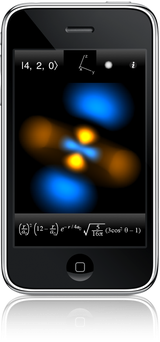|
Huntington Beach, CA, USA - July 11, 2008 - Dauger Research, Inc.,
proudly introduces Atom in a Box for the iPhone. The popular,
award-winning Atom in a Box educational and scientific software uses 3D
real-time volumetric raytracing to present what the Hydrogen atom
"looks" like. By presenting the Hydrogenic atomic orbitals in an
intuitive user interface, Atom in a Box stimulates appreciation of the
aesthetic in science yet portrays its subject faithfully, appealing to
all from children to Nobel laureates. Long available on the Mac, Atom
in a Box is available today internationally via Apple's new App Store
for the iPod Touch and the iPhone.
"Atom in a Box was a side project while I was a physics graduate student
at UCLA", says Dean Dauger, President of Dauger Research, Inc. "I
wanted to 'see' an atom for myself, imagining that I could touch a
quantum orbital. Now we can get even closer to holding an atom using a
handheld multitouch device like the iPhone. We are grateful for all the
wonderful feedback from people about Atom in a Box, so we hope to share
our fascination with science renewed in the next computing generation."
"Dean Dauger's marvelous 'Atom in a Box' shows the lovely, almost
sensuous patterns of undulating waves that describe the possible states
of that simplest of atoms, Hydrogen. I hope you will explore 'Atom in a
Box' for yourself." - 2004 Physics Nobel Laureate and Herman Feshbach
Professor of Physics at MIT Frank Wilczek
Winner in Computers In Physics' Ninth Annual Educational Software
Contest, Atom in a Box applies highly-optimized code to directly
calculate the otherwise unwieldy quantum mechanical wavefunction of an
electron while it occupies any of the 140 eigenstates up to the n=7
energy level of the Hydrogen atom. The app integrates these complex
values using Simpson's Rule through a path in 3D space to generate pixel
brightnesses. Via the iPhone's multitouch interface and accelerometer,
the user can reorient and interact with the atomic orbital. The software
is even able to show the "flow" of the electron around the orbital by
presenting the time-evolving phase of the wavefunction as color.
|
|

|

